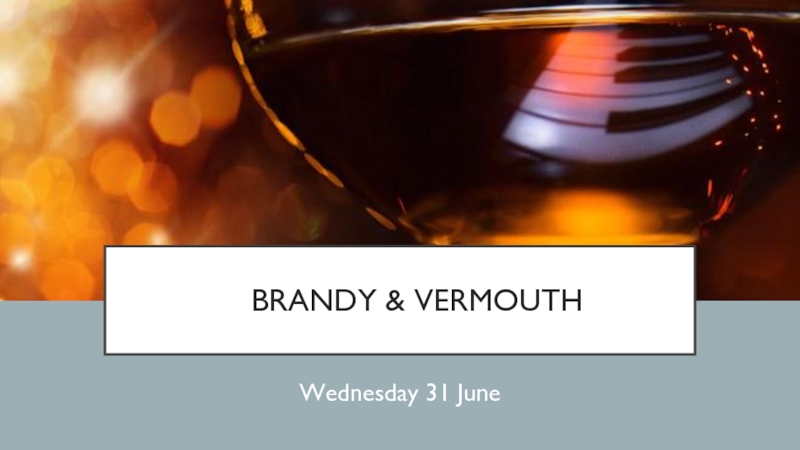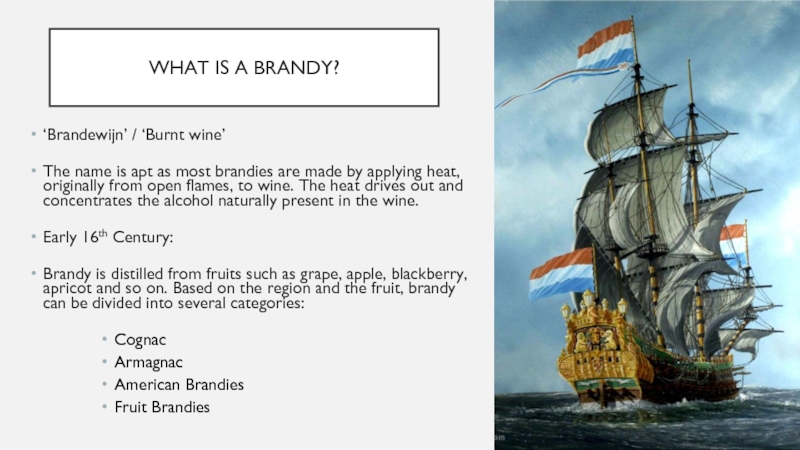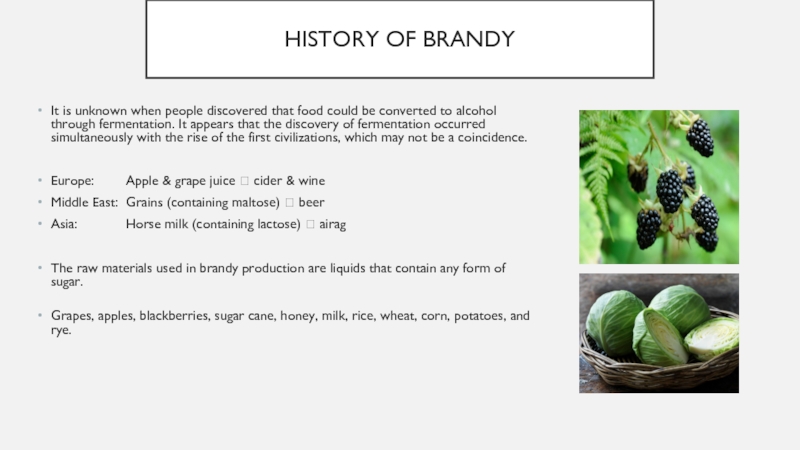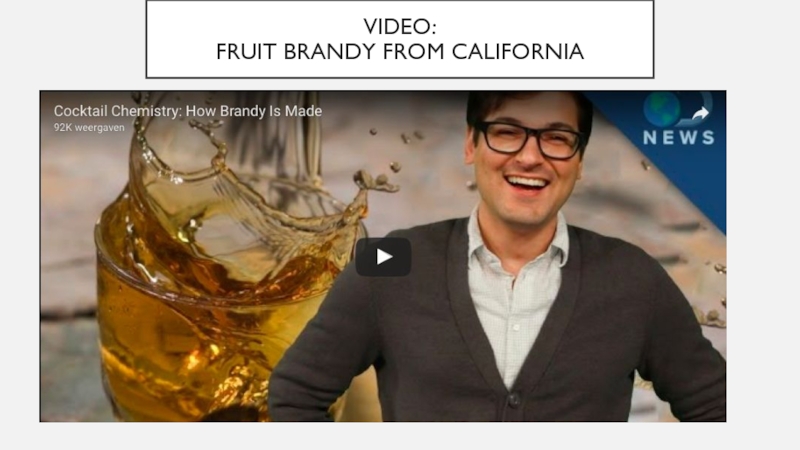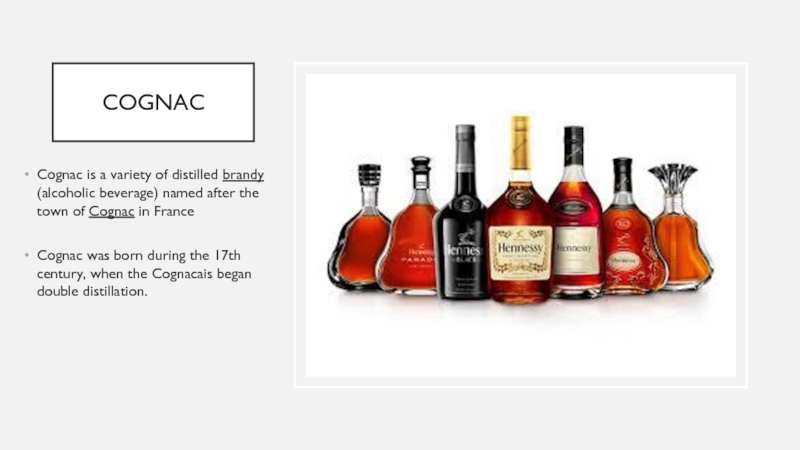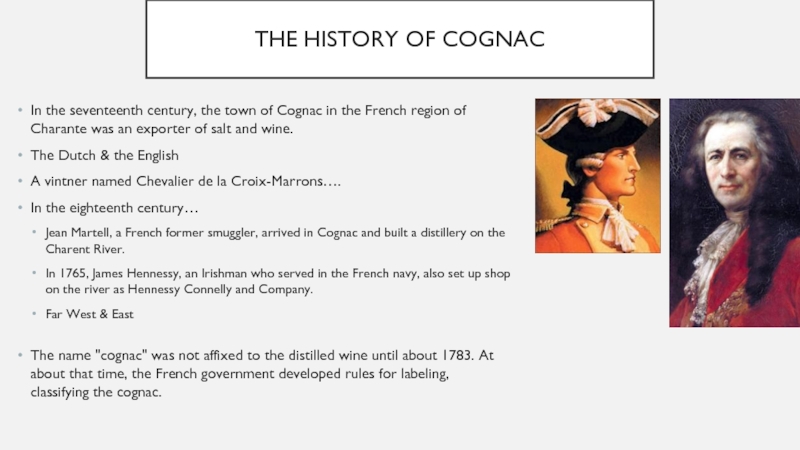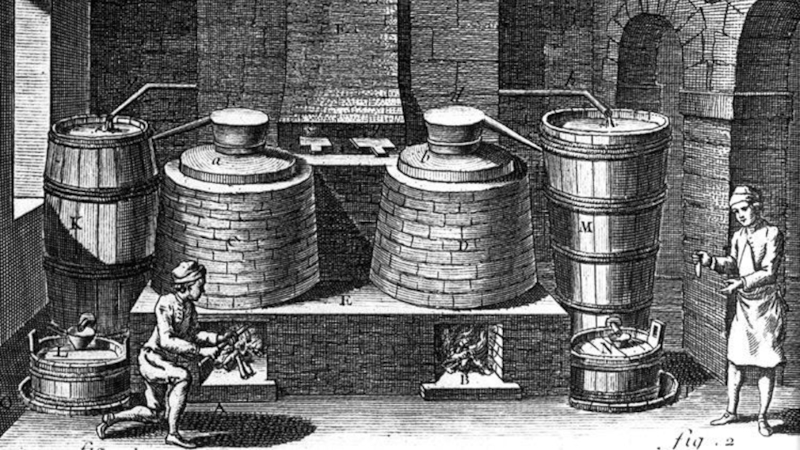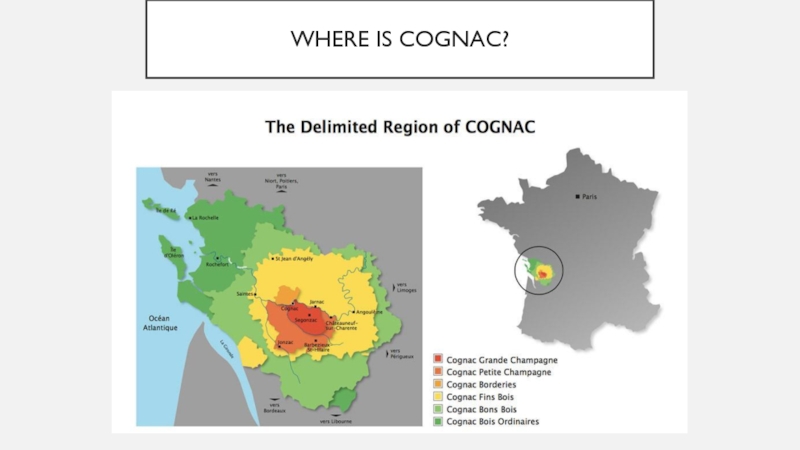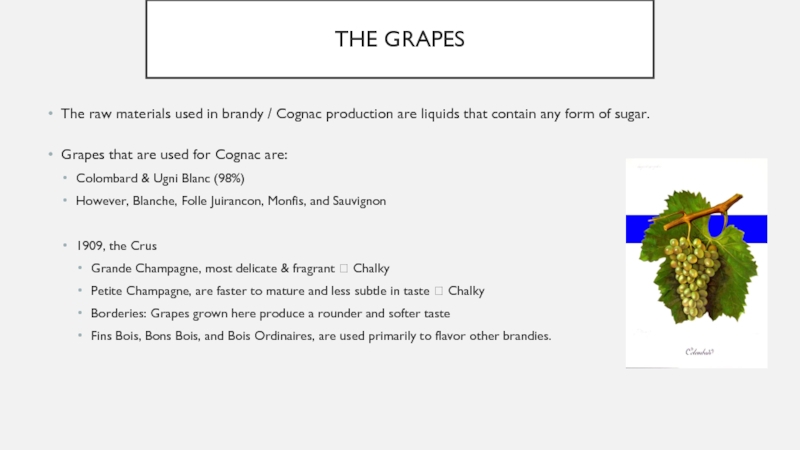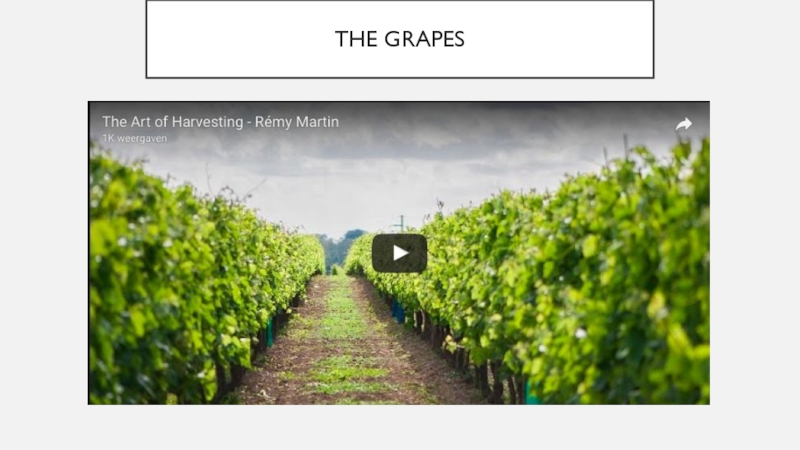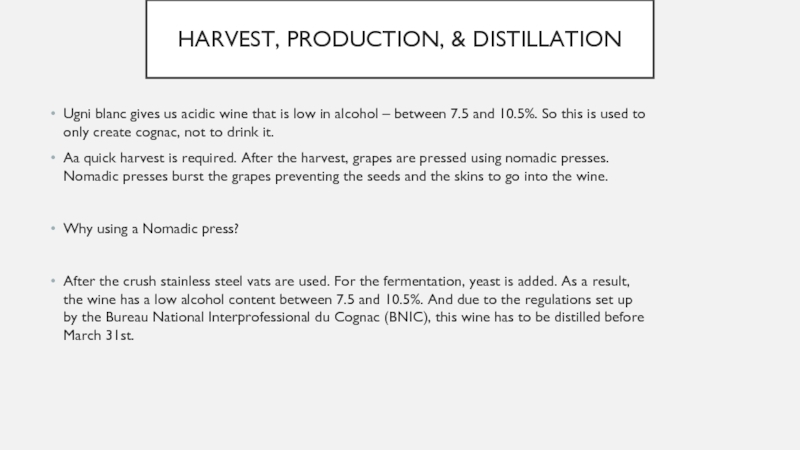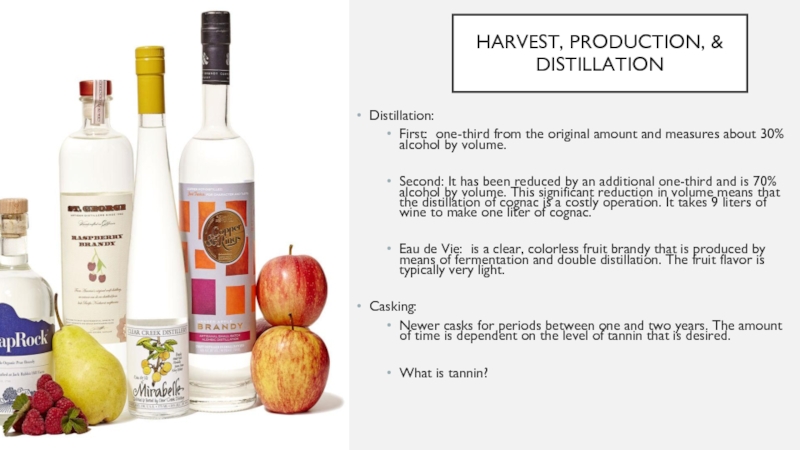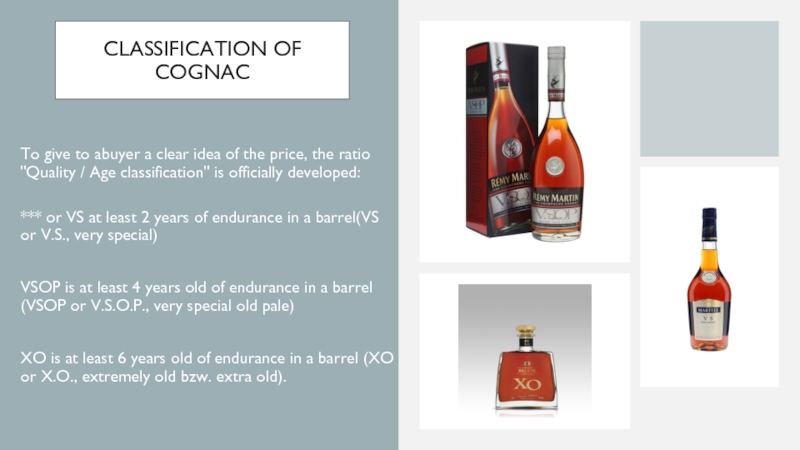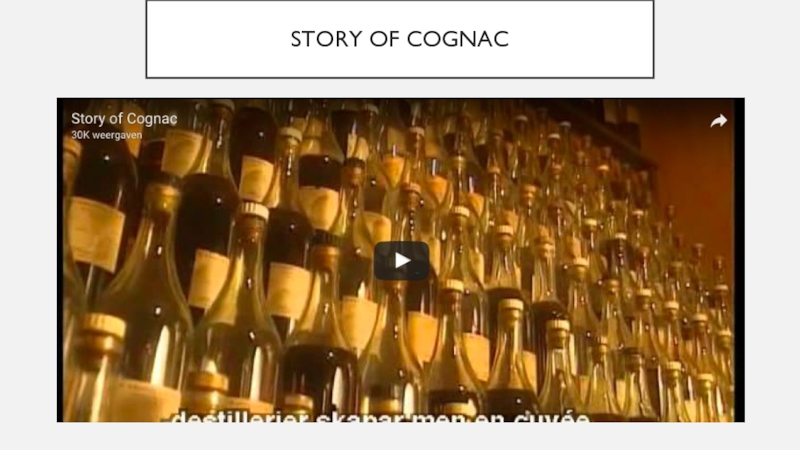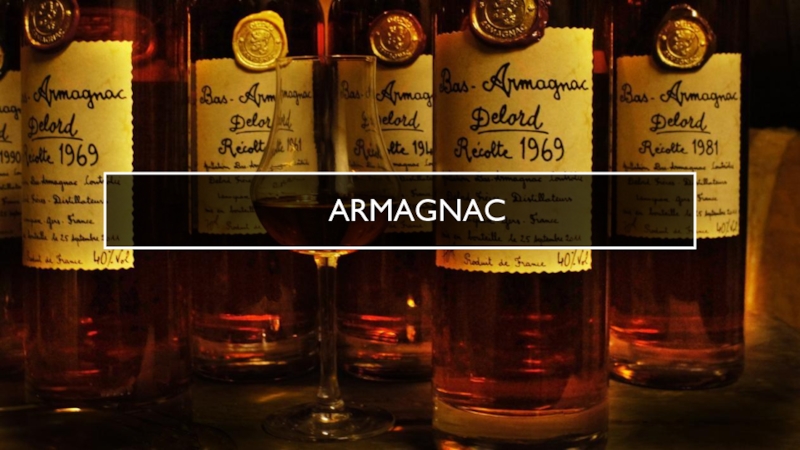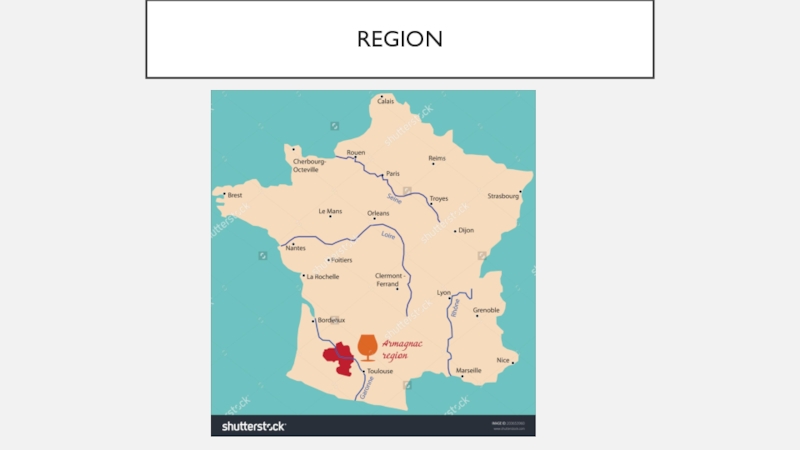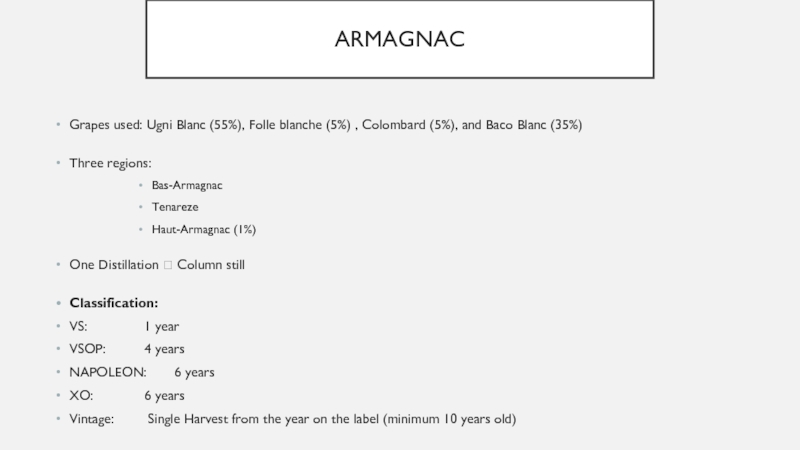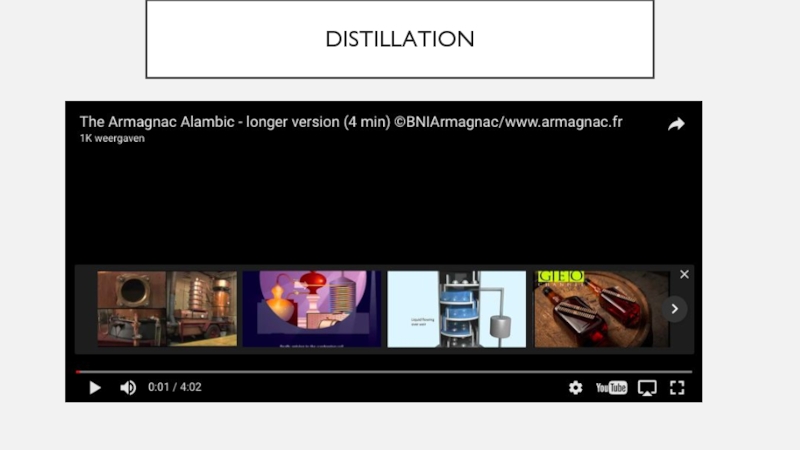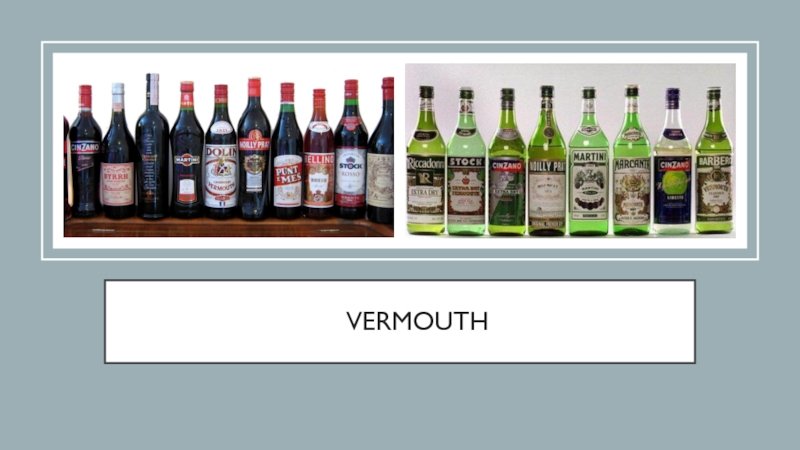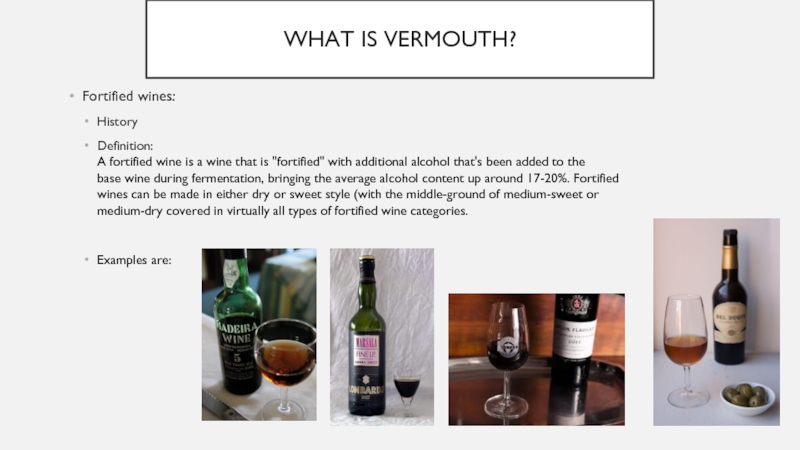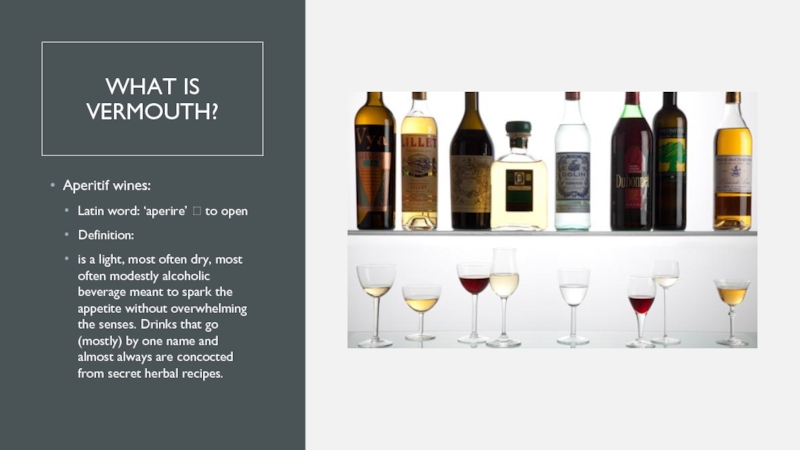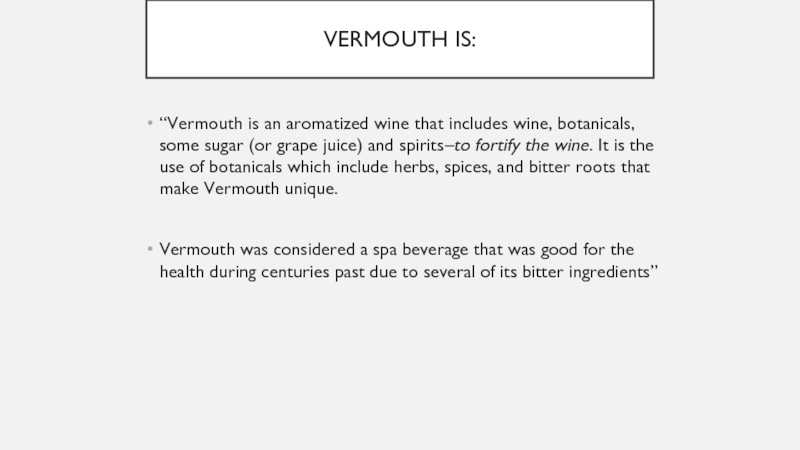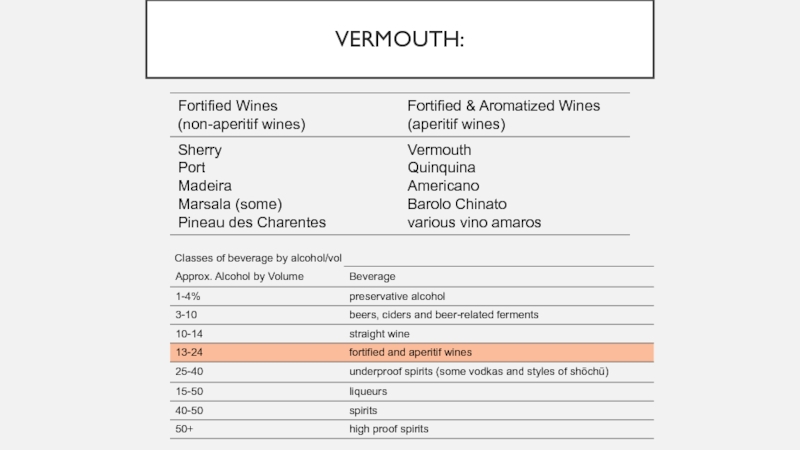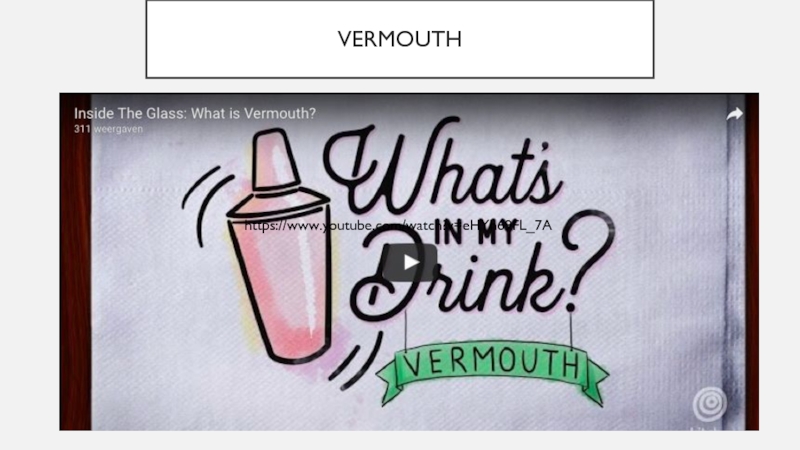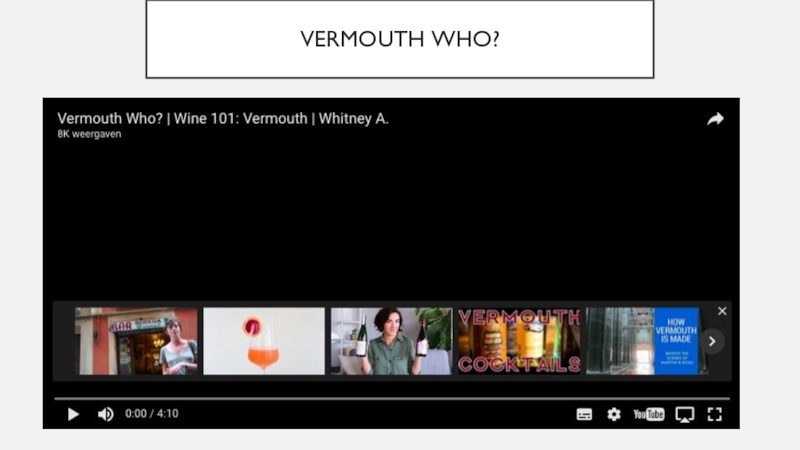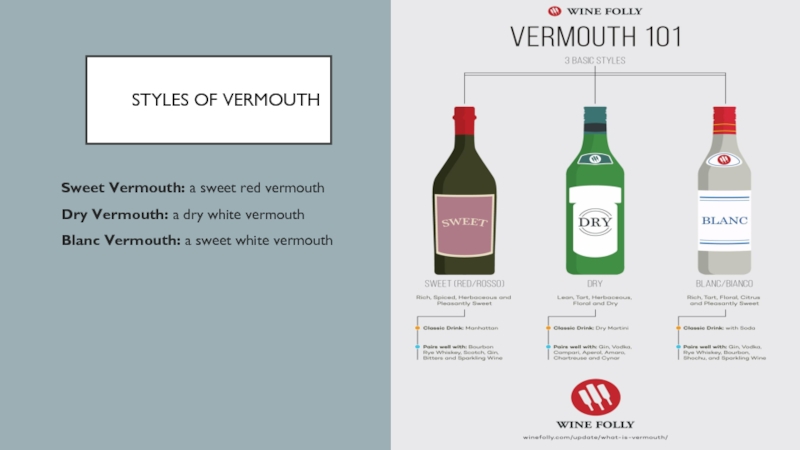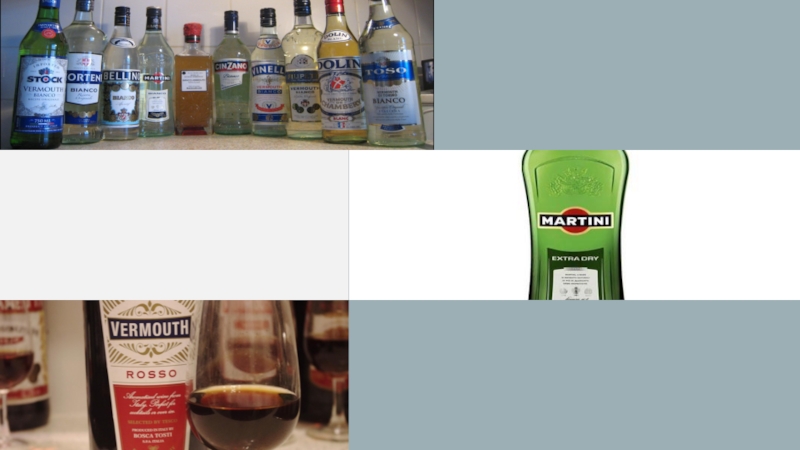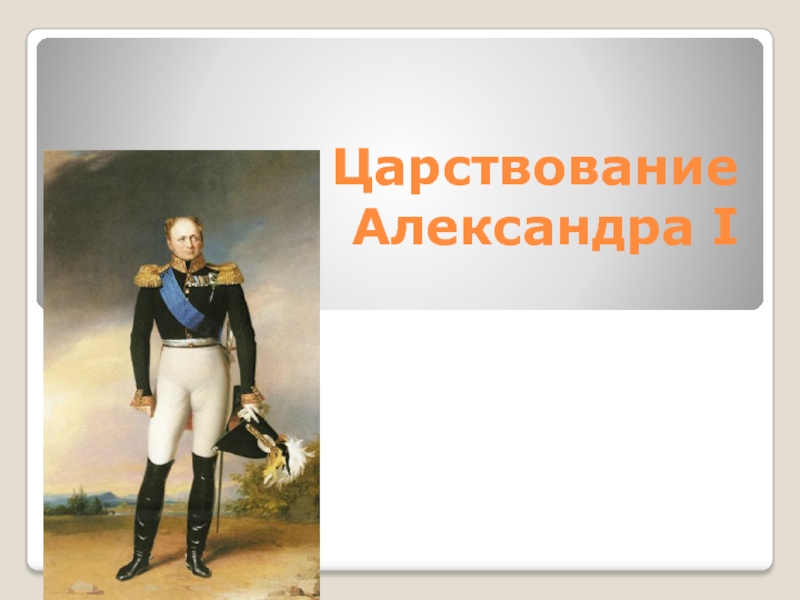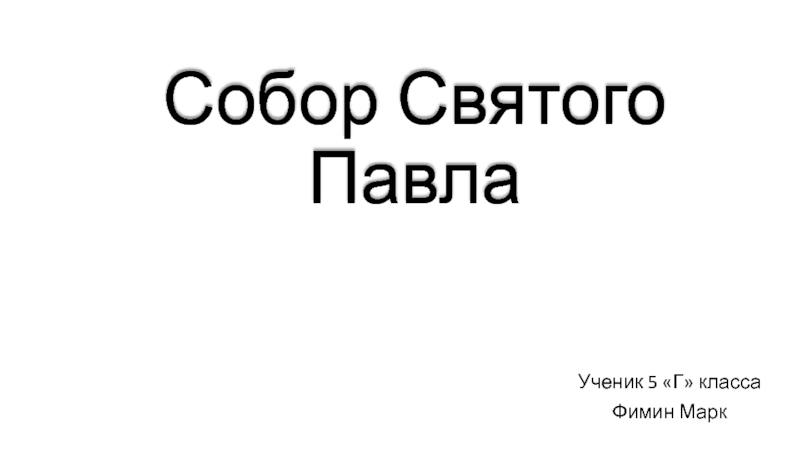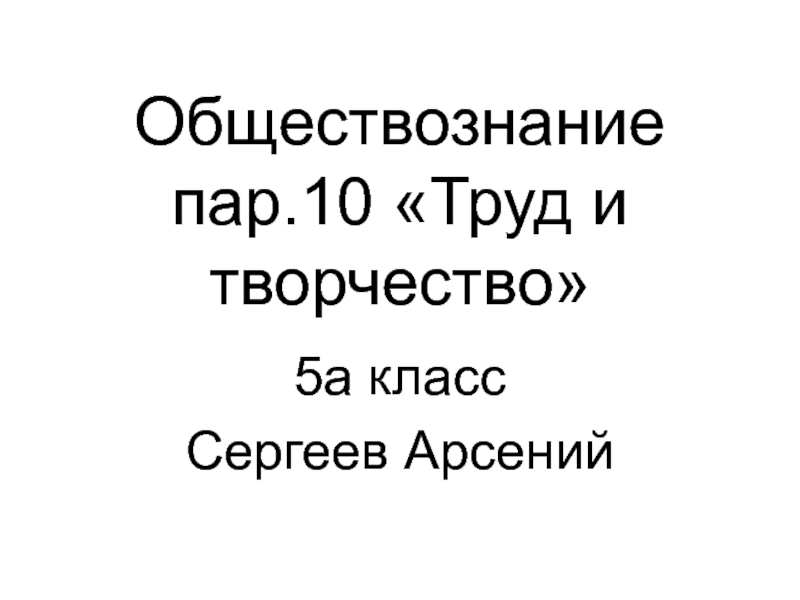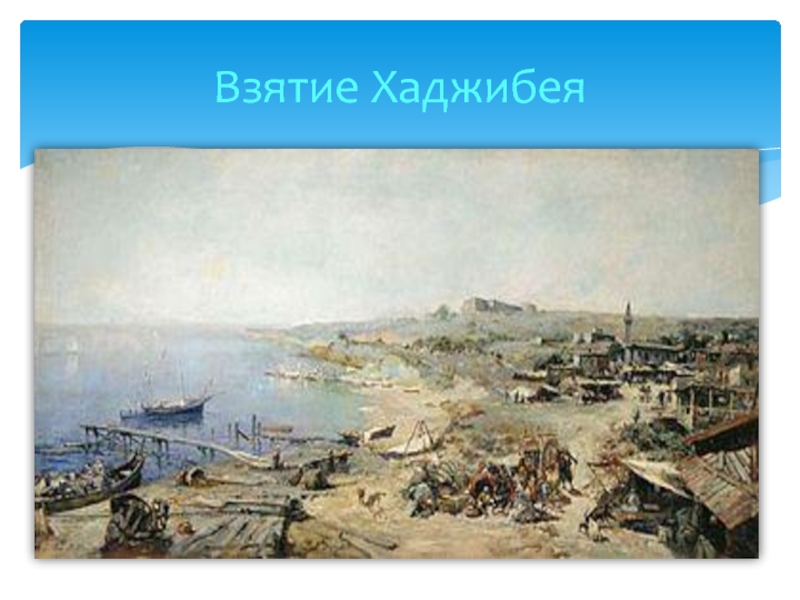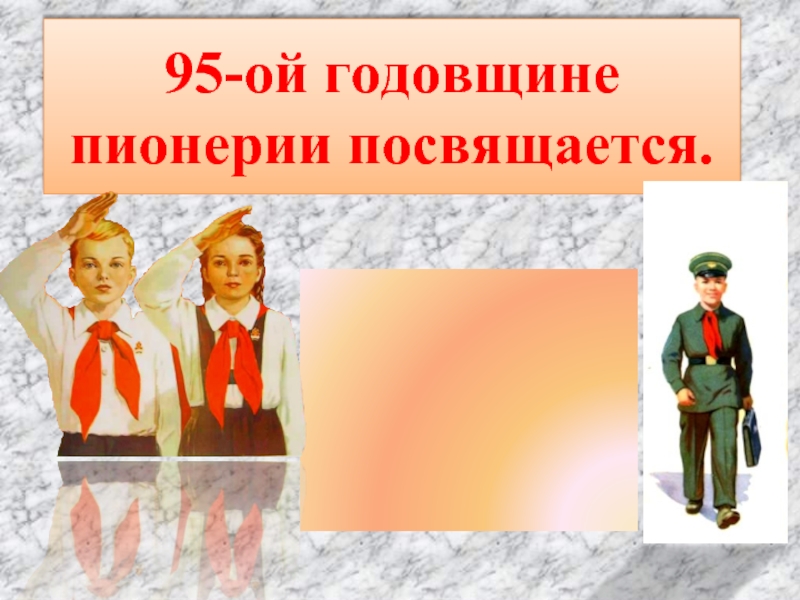- Главная
- Разное
- Дизайн
- Бизнес и предпринимательство
- Аналитика
- Образование
- Развлечения
- Красота и здоровье
- Финансы
- Государство
- Путешествия
- Спорт
- Недвижимость
- Армия
- Графика
- Культурология
- Еда и кулинария
- Лингвистика
- Английский язык
- Астрономия
- Алгебра
- Биология
- География
- Детские презентации
- Информатика
- История
- Литература
- Маркетинг
- Математика
- Медицина
- Менеджмент
- Музыка
- МХК
- Немецкий язык
- ОБЖ
- Обществознание
- Окружающий мир
- Педагогика
- Русский язык
- Технология
- Физика
- Философия
- Химия
- Шаблоны, картинки для презентаций
- Экология
- Экономика
- Юриспруденция
Brandy & Vermouth. History of Brandy презентация
Содержание
- 1. Brandy & Vermouth. History of Brandy
- 2. WHAT IS A BRANDY? ‘Brandewijn’ / ‘Burnt
- 3. HISTORY OF BRANDY It is unknown when
- 4. VIDEO: FRUIT BRANDY FROM CALIFORNIA
- 5. COGNAC Cognac is a variety
- 6. THE HISTORY OF COGNAC In the seventeenth
- 8. WHERE IS COGNAC?
- 9. THE GRAPES The raw materials used in
- 10. THE GRAPES
- 11. HARVEST, PRODUCTION, & DISTILLATION Ugni blanc gives
- 12. HARVEST, PRODUCTION, & DISTILLATION Distillation: First: one-third
- 13. CLASSIFICATION OF
- 14. STORY OF COGNAC
- 15. ARMAGNAC
- 16. REGION
- 17. ARMAGNAC Grapes used: Ugni Blanc (55%), Folle
- 18. DISTILLATION
- 19. VERMOUTH
- 20. WHAT IS VERMOUTH? Fortified wines: History
- 21. WHAT IS VERMOUTH? Aperitif wines:
- 22. VERMOUTH IS: “Vermouth is an aromatized wine
- 23. VERMOUTH:
- 24. VERMOUTH https://www.youtube.com/watch?v=eHYh69FL_7A
- 25. VERMOUTH WHO?
- 26. STYLES OF VERMOUTH Sweet Vermouth: a sweet
Слайд 2WHAT IS A BRANDY?
‘Brandewijn’ / ‘Burnt wine’
The name is apt as
most brandies are made by applying heat, originally from open flames, to wine. The heat drives out and concentrates the alcohol naturally present in the wine.
Early 16th Century:
Brandy is distilled from fruits such as grape, apple, blackberry, apricot and so on. Based on the region and the fruit, brandy can be divided into several categories:
Cognac
Armagnac
American Brandies
Fruit Brandies
Early 16th Century:
Brandy is distilled from fruits such as grape, apple, blackberry, apricot and so on. Based on the region and the fruit, brandy can be divided into several categories:
Cognac
Armagnac
American Brandies
Fruit Brandies
Слайд 3HISTORY OF BRANDY
It is unknown when people discovered that food could
be converted to alcohol through fermentation. It appears that the discovery of fermentation occurred simultaneously with the rise of the first civilizations, which may not be a coincidence.
Europe: Apple & grape juice ? cider & wine
Middle East: Grains (containing maltose) ? beer
Asia: Horse milk (containing lactose) ? airag
The raw materials used in brandy production are liquids that contain any form of sugar.
Grapes, apples, blackberries, sugar cane, honey, milk, rice, wheat, corn, potatoes, and rye.
Europe: Apple & grape juice ? cider & wine
Middle East: Grains (containing maltose) ? beer
Asia: Horse milk (containing lactose) ? airag
The raw materials used in brandy production are liquids that contain any form of sugar.
Grapes, apples, blackberries, sugar cane, honey, milk, rice, wheat, corn, potatoes, and rye.
Слайд 5
COGNAC
Cognac is a variety of distilled brandy (alcoholic beverage) named after
the town of Cognac in France
Cognac was born during the 17th century, when the Cognacais began double distillation.
Cognac was born during the 17th century, when the Cognacais began double distillation.
Слайд 6THE HISTORY OF COGNAC
In the seventeenth century, the town of Cognac
in the French region of Charante was an exporter of salt and wine.
The Dutch & the English
A vintner named Chevalier de la Croix-Marrons….
In the eighteenth century…
Jean Martell, a French former smuggler, arrived in Cognac and built a distillery on the Charent River.
In 1765, James Hennessy, an Irishman who served in the French navy, also set up shop on the river as Hennessy Connelly and Company.
Far West & East
The name "cognac" was not affixed to the distilled wine until about 1783. At about that time, the French government developed rules for labeling, classifying the cognac.
The Dutch & the English
A vintner named Chevalier de la Croix-Marrons….
In the eighteenth century…
Jean Martell, a French former smuggler, arrived in Cognac and built a distillery on the Charent River.
In 1765, James Hennessy, an Irishman who served in the French navy, also set up shop on the river as Hennessy Connelly and Company.
Far West & East
The name "cognac" was not affixed to the distilled wine until about 1783. At about that time, the French government developed rules for labeling, classifying the cognac.
Слайд 9THE GRAPES
The raw materials used in brandy / Cognac production are
liquids that contain any form of sugar.
Grapes that are used for Cognac are:
Colombard & Ugni Blanc (98%)
However, Blanche, Folle Juirancon, Monfis, and Sauvignon
1909, the Crus
Grande Champagne, most delicate & fragrant ? Chalky
Petite Champagne, are faster to mature and less subtle in taste ? Chalky
Borderies: Grapes grown here produce a rounder and softer taste
Fins Bois, Bons Bois, and Bois Ordinaires, are used primarily to flavor other brandies.
Grapes that are used for Cognac are:
Colombard & Ugni Blanc (98%)
However, Blanche, Folle Juirancon, Monfis, and Sauvignon
1909, the Crus
Grande Champagne, most delicate & fragrant ? Chalky
Petite Champagne, are faster to mature and less subtle in taste ? Chalky
Borderies: Grapes grown here produce a rounder and softer taste
Fins Bois, Bons Bois, and Bois Ordinaires, are used primarily to flavor other brandies.
Слайд 11HARVEST, PRODUCTION, & DISTILLATION
Ugni blanc gives us acidic wine that is
low in alcohol – between 7.5 and 10.5%. So this is used to only create cognac, not to drink it.
Aa quick harvest is required. After the harvest, grapes are pressed using nomadic presses. Nomadic presses burst the grapes preventing the seeds and the skins to go into the wine.
Why using a Nomadic press?
After the crush stainless steel vats are used. For the fermentation, yeast is added. As a result, the wine has a low alcohol content between 7.5 and 10.5%. And due to the regulations set up by the Bureau National Interprofessional du Cognac (BNIC), this wine has to be distilled before March 31st.
Aa quick harvest is required. After the harvest, grapes are pressed using nomadic presses. Nomadic presses burst the grapes preventing the seeds and the skins to go into the wine.
Why using a Nomadic press?
After the crush stainless steel vats are used. For the fermentation, yeast is added. As a result, the wine has a low alcohol content between 7.5 and 10.5%. And due to the regulations set up by the Bureau National Interprofessional du Cognac (BNIC), this wine has to be distilled before March 31st.
Слайд 12HARVEST, PRODUCTION, & DISTILLATION
Distillation:
First: one-third from the original amount and measures
about 30% alcohol by volume.
Second: It has been reduced by an additional one-third and is 70% alcohol by volume. This significant reduction in volume means that the distillation of cognac is a costly operation. It takes 9 liters of wine to make one liter of cognac.
Eau de Vie: is a clear, colorless fruit brandy that is produced by means of fermentation and double distillation. The fruit flavor is typically very light.
Casking:
Newer casks for periods between one and two years. The amount of time is dependent on the level of tannin that is desired.
What is tannin?
Second: It has been reduced by an additional one-third and is 70% alcohol by volume. This significant reduction in volume means that the distillation of cognac is a costly operation. It takes 9 liters of wine to make one liter of cognac.
Eau de Vie: is a clear, colorless fruit brandy that is produced by means of fermentation and double distillation. The fruit flavor is typically very light.
Casking:
Newer casks for periods between one and two years. The amount of time is dependent on the level of tannin that is desired.
What is tannin?
Слайд 13
CLASSIFICATION OF COGNAC
To give to abuyer a clear idea of the
price, the ratio "Quality / Age classification" is officially developed:
*** or VS at least 2 years of endurance in a barrel(VS or V.S., very special)
VSOP is at least 4 years old of endurance in a barrel (VSOP or V.S.O.P., very special old pale)
XO is at least 6 years old of endurance in a barrel (XO or X.O., extremely old bzw. extra old).
*** or VS at least 2 years of endurance in a barrel(VS or V.S., very special)
VSOP is at least 4 years old of endurance in a barrel (VSOP or V.S.O.P., very special old pale)
XO is at least 6 years old of endurance in a barrel (XO or X.O., extremely old bzw. extra old).
Слайд 17ARMAGNAC
Grapes used: Ugni Blanc (55%), Folle blanche (5%) , Colombard (5%),
and Baco Blanc (35%)
Three regions:
Bas-Armagnac
Tenareze
Haut-Armagnac (1%)
One Distillation ? Column still
Classification:
VS: 1 year
VSOP: 4 years
NAPOLEON: 6 years
XO: 6 years
Vintage: Single Harvest from the year on the label (minimum 10 years old)
Three regions:
Bas-Armagnac
Tenareze
Haut-Armagnac (1%)
One Distillation ? Column still
Classification:
VS: 1 year
VSOP: 4 years
NAPOLEON: 6 years
XO: 6 years
Vintage: Single Harvest from the year on the label (minimum 10 years old)
Слайд 20WHAT IS VERMOUTH?
Fortified wines:
History
Definition:
A fortified wine is a wine that
is "fortified" with additional alcohol that's been added to the base wine during fermentation, bringing the average alcohol content up around 17-20%. Fortified wines can be made in either dry or sweet style (with the middle-ground of medium-sweet or medium-dry covered in virtually all types of fortified wine categories.
Examples are:
Examples are:
Слайд 21
WHAT IS VERMOUTH?
Aperitif wines:
Latin word: ‘aperire’ ? to open
Definition:
is a light,
most often dry, most often modestly alcoholic beverage meant to spark the appetite without overwhelming the senses. Drinks that go (mostly) by one name and almost always are concocted from secret herbal recipes.
Слайд 22VERMOUTH IS:
“Vermouth is an aromatized wine that includes wine, botanicals, some
sugar (or grape juice) and spirits–to fortify the wine. It is the use of botanicals which include herbs, spices, and bitter roots that make Vermouth unique.
Vermouth was considered a spa beverage that was good for the health during centuries past due to several of its bitter ingredients”
Vermouth was considered a spa beverage that was good for the health during centuries past due to several of its bitter ingredients”
Слайд 26
STYLES OF VERMOUTH
Sweet Vermouth: a sweet red vermouth
Dry Vermouth: a dry white vermouth
Blanc
Vermouth: a sweet white vermouth
